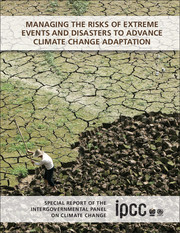 Managing the Risks of Extreme Events and Disasters to Advance Climate Change Adaptation
Managing the Risks of Extreme Events and Disasters to Advance Climate Change Adaptation from Section III
Published online by Cambridge University Press: 05 August 2012
Executive Summary
The severity of the impacts of extreme and non-extreme weather and climate events depends strongly on the level of vulnerability and exposure to these events (high confidence). [2.2.1, 2.3, 2.5] Trends in vulnerability and exposure are major drivers of changes in disaster risk, and of impacts when risk is realized (high confidence). [2.5] Understanding the multi-faceted nature of vulnerability and exposure is a prerequisite for determining how weather and climate events contribute to the occurrence of disasters, and for designing and implementing effective adaptation and disaster risk management strategies. [2.2, 2.6]
Vulnerability and exposure are dynamic, varying across temporal and spatial scales, and depend on economic, social, geographic, demographic, cultural, institutional, governance, and environmental factors (high confidence). [2.2, 2.3, 2.5] Individuals and communities are differentially exposed and vulnerable and this is based on factors such as wealth, education, race/ethnicity/religion, gender, age, class/caste, disability, and health status. [2.5] Lack of resilience and capacity to anticipate, cope with, and adapt to extremes and change are important causal factors of vulnerability. [2.4]
Extreme and non-extreme weather and climate events also affect vulnerability to future extreme events, by modifying the resilience, coping, and adaptive capacity of communities, societies, or social-ecological systems affected by such events (high confidence). [2.4.3] At the far end of the spectrum – low-probability, highintensity events – the intensity of extreme climate and weather events and exposure to them tend to be more pervasive in explaining disaster loss than vulnerability in explaining the level of impact.
To save this book to your Kindle, first ensure [email protected] is added to your Approved Personal Document E-mail List under your Personal Document Settings on the Manage Your Content and Devices page of your Amazon account. Then enter the ‘name’ part of your Kindle email address below. Find out more about saving to your Kindle.
Note you can select to save to either the @free.kindle.com or @kindle.com variations. ‘@free.kindle.com’ emails are free but can only be saved to your device when it is connected to wi-fi. ‘@kindle.com’ emails can be delivered even when you are not connected to wi-fi, but note that service fees apply.
Find out more about the Kindle Personal Document Service.
To save content items to your account, please confirm that you agree to abide by our usage policies. If this is the first time you use this feature, you will be asked to authorise Cambridge Core to connect with your account. Find out more about saving content to Dropbox.
To save content items to your account, please confirm that you agree to abide by our usage policies. If this is the first time you use this feature, you will be asked to authorise Cambridge Core to connect with your account. Find out more about saving content to Google Drive.